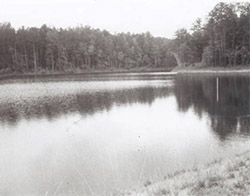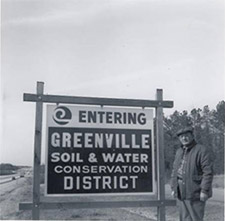History of Watershed Dams

Recognizing that serious problems of water management resulting from erosion, floodwater, or sediment damages were arising in
the watersheds of the rivers and streams of the state of South Carolina, the SC legislature established the Watershed District Law,
SC Code of Laws-Title 48-Chapter 11-Watershed Conservation Districts. Watershed conservation districts were established as provided
in that chapter within one or more soil and water conservation districts to develop and execute plans and programs relating to a
phase of the control or prevention of soil erosion or flooding; the conservation, protection, improvement, development, or utilization
of soil and water resources; stormwater management; or the disposal of water. This authority applied, but is not limited to, the
planning and carrying out of works of improvement for the foregoing purposes which may be considered by the United States Secretary
of Agriculture. In other words: Watershed Districts were created to control flooding and soil erosion in their jurisdiction.
The Watershed Protection and Flood Prevention Act of 1954, Public Law 83-566, also known simply as PL-566, authorized the
Secretary of Agriculture to assist local units of government to provide protection from flooding during major storm events within sub-basins of
identified watersheds, within our major river systems. Erosion, floodwater, and sediment damages in the watersheds of the rivers and streams
of the United States, causing loss of life and damage to property, constitute a menace to the national welfare; and it is the sense of
Congress that the Federal Government should cooperate with States and their political subdivisions, soil or water conservation districts,
flood prevention or control districts, and other local public agencies for the purpose of preventing such damages, of furthering the
conservation, development, utilization, and disposal of water, and the conservation and utilization of land and thereby of preserving,
protecting, and improving the Nation's waterways. In other words: Areas of heavy flooding were identified, a survey was done, and funding
was requested under PL-566 to construct a series of dams in the watershed for the purpose of flood control. In South Carolina, the USDA-NRCS
provided technical and design information, a local sponsor (South Tyger River Watershed Conservation District and the Greenville Soil and Water
Conservation District) gained and held the easements ( as well as met the actual operation and maintenance requirements), and the SCDNR provides
information on the organization and function of these watersheds. The dams were created for flood control!! The primary spillways are designed
to slowly release water to decrease the chances of a downstream flood event. In order to make this possible, the local sponsor gained easements
up to the proposed top of dam elevation. This elevation provides the necessary storage area to detain excess stormwater. These easements were
legally recorded in the Greenville County RMC office. The validity of the easements has been upheld in the SC Supreme Court Case 96-CP-23-1538.
The sponsor has the responsibility to maintain these dams to allow for safe and efficient operation. The maintenance consists of but is not
limited to: mowing vegetation on the dams, replacing or repairing damaged primary spillway hardware, ensuring that the auxiliary spillway is
free of obstructions, and performing periodic inspections of the dams.

"We do not inherit the land from our ancestors, we borrow it from our children."
-Native American Proverb